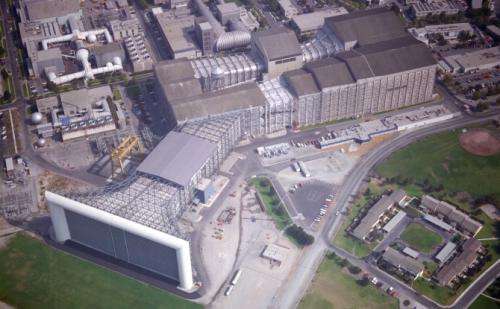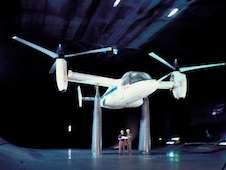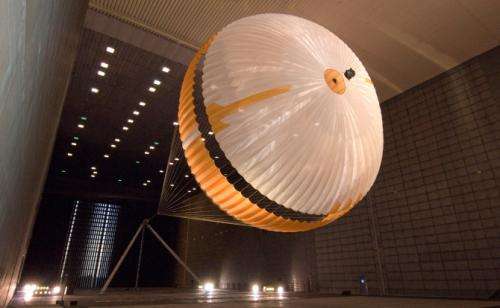Sometimes size does matter: 25 years with the largest wind tunnel in the world

(Phys.org)—California's Silicon Valley has become known for its ability to make things almost infinitely tiny. Unbeknownst to many, it is also home to a few huge structures, including the largest wind tunnel in the world.
Wind tunnels have been used for more than a hundred years to model airplanes as they would appear in flight by moving air past them while stationary. The results are similar to those attained by testing an object while speeding through the air.
The facility, which was built in 1944 at what was then the National Advisory Council for Aeronautics' (NACA) Ames Aeronautical Laboratory (now NASA's Ames Research Center), housed an impressive 40-foot-by-80-foot test section. However, even after the 1987 addition of a tunnel twice as high and half again as wide, the National Full-Scale Aerodynamics Complex (NFAC), as the tunnels are jointly named, was not able to claim its title until the beginning of the last decade of the 20th century.
This is because, until 1986, the United States did not have accurate information on the state of Soviet aerodynamics facilities. For forty full years before the fall of the Soviet Union, the NFAC had housed first the largest, and then the two largest wind tunnels in the world. But no one could say for sure. Long after the Cold War it is a record it continues to hold.
But what makes the size of these tunnels so important?
Most wind tunnels are built to test small models of aircraft a few feet wide. A facility with a 40-foot-by-80-foot test section, like the one constructed between the war years of 1942 and 1944 at Ames, had the ability to test full-sized fighter aircraft without creating smaller models and then scaling the results. The more accurate data primarily was used to help find new ways to reduce the drag of small aircraft, such as military fighters, and to improve their landing performance.
Despite the success of the 40-foot-by-80-foot tunnel, regional and national aeronautics needs increased and more diverse capabilities were needed for testing new kinds of vehicles. Due to new areas of research interest, the 200 knot (230 mph) maximum air speed and even the generous size of the tunnel were found to be a limitation.

Rather than build a whole new tunnel, it was decided in the 1970s that an 80-foot-by-120-foot test section would be added onto a repowered 40-foot-by-80-foot-tunnel. The project's cost was estimated to be at least ten times less than the building of an entire new facility.
Ground breaking took place in November 1978, after performing more than 600 research tests. In June 1980 it was time, temporarily, to close the 40-foot-by-80-foot wind tunnel for repowering.
Despite an accident during an integrated systems test that caused some damage in 1982, the huge new wind tunnel was dedicated on Dec. 11,1987. The National Full-Scale Aerodynamics Complex (NFAC) was selected as the name for both tunnels and the nearby Outdoor Aeronautic Research Facility (OARF), used for evaluating aircraft prior to wind tunnel entry.
After repowering, the smaller section's top wind speed was increased to 300 knots (345 mph) while the large section, which is big enough to test a Boeing 737, has a top speed of 100 knots (115 mph). These speeds are created using a common, six-fan drive system. The 40-foot diameter fans have 15 laminated wooden blades and, when operating at full power, turn 180 revolutions per minute. To move 60 tons of air per second, the tunnel uses 104 megawatts of electricity or the equivalent of a 225,000-person city.
During its long history, the NFAC has conducted an incredible variety of tests. Bill Warmbrodt, chief of the Aeromechanics Branch at Ames, recounts:

"The 80x120 was developed to test Vertical Take Off and Landing (VTOL) aircraft and rotorcraft at low speeds. Yes, we tested the 86-percent scale F-35 Lightning prototype in 1998 and a full-scale UH-60A Black Hawk rotor with Individual Blade Control in 2000. These were aeronautical tests for Department of Defense aircraft. Yet it was surprising in 1993 to see the space shuttle drag chute being tested with modifications to improve drag performance with reduced buffeting. This led to changes in the chute that then flew on every space shuttle mission after that test. And now the Air Force is working with NASA on developing new decelerator technology for atmospheric entry into Mars and other planets. It seems that parachute testing is something that really can only be done at large/full scale to get the right answers."
A large number of rotorcraft tests have been and continue to be conducted and the U.S. Marine's V-22 Osprey tilt rotor and its precursor, the XV-15 tilt rotor research aircraft are notable examples. This is because the NFAC is uniquely qualified to perform research on full- or large-scale rotorcraft. Model studies of rotorcraft are limited because of conflicting aerodynamic and aeroelastic requirements (the way they interact with the air is far more complicated than fixed wing aircraft). Despite becoming increasingly useful, computational fluid dynamic testing (which use computers to simulate airflow over objects) has had limited success dealing with the highly complex interaction between air and the rotor blades.
Numerous civil aircraft have also been tested inside the unique facility. NASA even tested a full-scale replica of the Wright brothers' first airplane in the 40-foot-by-80-foot test section in 1999.
Testing is not confined to aircraft, however. Lawrence Livermore National Labs (LLNL), Navistar and the Department of Energy conducted tests aimed at aerodynamic truck and trailer devices designed to reduce fuel consumption at highway speed by 10 percent. Together with NASA, the Department of Energy tested green energy wind turbines on Earth Day in 2000.
Memorably, the second test ever conducted in the 80-foot-by-120-foot tunnel was for the Space Shuttle Program's drag parachute. This was the first of many space-related tests which included a one-third model Shuttle and full-scale testing of the Mars Science Laboratory Curiosity rover's decelerator parachute last August.
Despite a history of success, a change in NASA's priorities, and a decline in new aircraft designs and manufacturers, the NFAC was closed by NASA in 2003 but, less than two years later, the U.S. Air Force was directed by the Department of Defense in 2005 to take over operation of the facility due to its need for high-accuracy rotorcraft testing. After two years of rehabilitation, maintenance, and repair the NFAC began testing again in 2007.
The continued use of the facility highlights the fact that, despite the increasing use of sophisticated computer modeling, wind tunnel testing is still essential. While the use of computers allows modeling and the introduction of a broader range of test conditions, because of their ability to produce highly accurate results in complex situations, wind tunnels like the NFAC will continue to play an important role in the development and testing of new aircraft and a variety of other aerospace vehicles in the future.
Provided by NASA





















